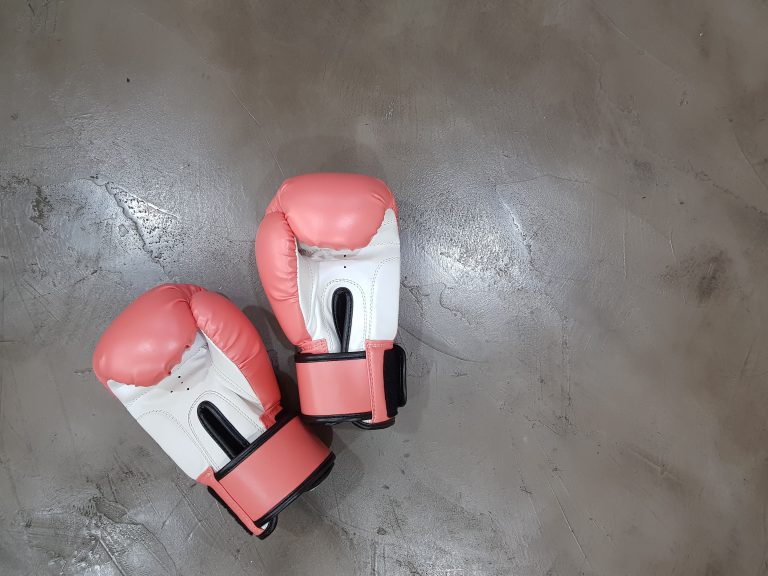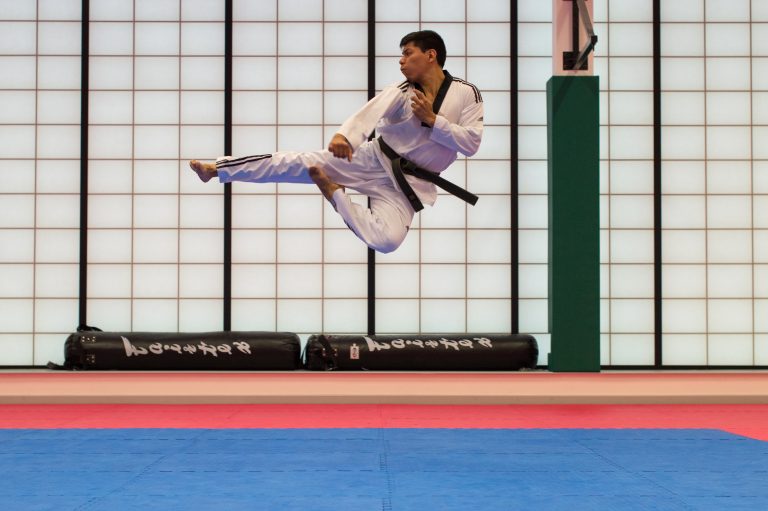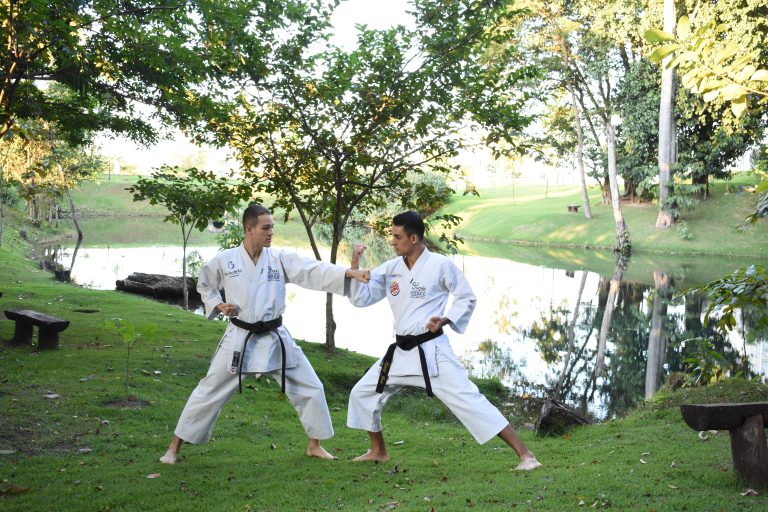The Different Colored Belts in Karate: A Guide for Beginners
Karate is a martial art that originated in Okinawa, Japan. It is known for its strong striking techniques, defensive moves, and use of different colored belts to signify a practitioner’s progress and skill level.
These colored belts, or „kyu“ belts in Japanese, are an important part of karate culture and help students understand their progress and set goals for improvement. In this blog post, we will dive into the different colored belts in karate and discuss what each one signifies.
White Belt – The Beginning of the Journey
Every karate journey begins with the white belt. This belt signifies that the martial artist is a beginner and has no previous knowledge of karate. The white belt is a symbol of a blank slate and an empty mind, ready to learn the fundamental skills of karate.
As a white belt, a student will learn basic moves such as punches, kicks, and blocks, along with basic stances and footwork. The first few months of training focus on building a strong foundation for future progress.
Yellow Belt – The First Step
After the white belt comes the yellow belt, which signifies a student’s progress and the first step in their karate journey. The yellow belt represents the beginning of growth and progress in a student’s journey.
As a yellow belt, a student will start to learn more advanced techniques and learn how to apply them in practical situations. This includes more advanced kicks, punches, and throws.
Orange Belt – Developing the Basics
The orange belt signifies a student who has been training for a few more months and has gained more knowledge and experience. At this stage, a student has become more comfortable with the basic moves and has started to refine their technique.
As an orange belt, a student will begin to focus on developing their basic techniques even further, building strength, speed, and accuracy. Students will also start to learn more complex techniques, such as joint locks and takedowns.
Green Belt – The Middle of the Journey
The green belt signifies a student who has been training for a significant amount of time and has demonstrated a solid foundation in the basic techniques of karate. At this stage, a student is considered to be halfway through their journey to black belt.
As a green belt, a student will start to focus on developing their speed and power, and learning more advanced kicking and punching combinations. They will also begin to learn more advanced kata, which are sequences of movements that simulate fighting against multiple opponents.
Blue Belt – The Journey Continues
The blue belt signifies a student who has continued their journey and has become even more skilled and knowledgeable in the art of karate. At this stage, a student is an intermediate in terms of their skill level, and has demonstrated the ability to understand more complex techniques.
As a blue belt, a student will continue to develop their strength, speed, and accuracy, and will start to learn more advanced sparring techniques. They will also begin to focus more on the mental aspects of karate, such as concentration and focus.
Purple Belt – A Step Closer to Mastery
The purple belt signifies a student who has been training for several years and has demonstrated a strong understanding of the fundamentals of karate. At this stage, a student is considered to be approaching mastery of the art.
As a purple belt, a student will focus on mastering the techniques they have learned so far, refining their technique and developing speed, power, and accuracy. They will also start to learn more advanced self-defense techniques.
Brown Belt – The Final Stage Before Black Belt
The brown belt signifies a student who has been training for a very long time and has demonstrated a high level of skill and knowledge in karate. At this stage, a student is considered an advanced practitioner and is almost ready to take the final step towards black belt.
As a brown belt, a student will focus on deepening their knowledge of the art of karate, learning more complex techniques, and refining their existing skills. They will also start to learn more advanced kata and weapon techniques.
Black Belt – The End of One Journey, the Beginning of Another
The black belt is the highest rank a karate student can achieve. It signifies an expert in the art of karate, someone who has demonstrated mastery of the fundamentals and is ready to embark on a new journey.
As a black belt, a practitioner will continue to refine their skills and knowledge, and will start to focus more on teaching and passing on their knowledge to others. They will also start to learn more advanced forms of sparring and self-defense.
What Are the Different Colored Belts in Karate?
Introduction
Karate is a martial art that has gained popularity worldwide due to its striking techniques, self-defense tactics, and forms known as Katas. One of the most recognizable aspects of karate is the colored belt system, which represents a practitioner’s level of skill, progress, and dedication. Understanding the different colored belts in karate is important for beginners and those interested in starting practice. In this blog post, we will cover the most frequently asked questions on this topic.
What Does the Color of the Belt Represent?
The colored belt system in karate typically starts with white and ends with black. Each color represents a certain level of proficiency and experience, as well as personal growth and development. The colors are not only an indicator of a practitioner’s skills, but they also reflect the values of discipline, perseverance, and respect.
What Is the Order of the Colored Belts in Karate?
The order of colored belts in karate varies by style and organization, but the most common sequence is:
– White
– Yellow
– Orange
– Green
– Blue
– Purple
– Brown
– Black
It is important to note that some schools may include additional belts or variations of the colors mentioned.
What Are the Requirements to Get a Colored Belt?
The requirements to earn a colored belt depend on the specific style and organization of karate a practitioner is studying. However, there are some general guidelines that most schools follow. These include:
– Demonstrating proficiency in basic techniques such as punches, kicks, and blocks
– Learning and performing Katas or forms specific to the level being tested
– Attending a certain number of classes or hours of training
– Showing discipline, respect, and dedication to the art
It is essential to understand that earning a new belt is not only about the physical aspect of the training but also mental and emotional development.
What Is the Timeframe to Move up to a New Colored Belt?
The timeframe to progress from one colored belt to the next varies depending on the student’s ability, dedication, and the policies set by their school or organization. Typically, it takes three to six months to advance from white belt to yellow belt and one to two years to reach brown belt. Advancement to higher levels usually takes several years of consistent training, effort, and perseverance.
What Are the Meanings Behind the Different Colored Belts?
In addition to representing proficiency levels, the colors of the belts in karate have various meanings that reflect the values and tenets of this martial art. Here are some common interpretations:
– White Belt: Represents purity, humility, and a beginner’s mindset
– Yellow Belt: Symbolizes the sun, and growth in terms of physical and mental attributes
– Orange Belt: Signifies a deeper understanding of the techniques and the beginning of intermediate-level training
– Green Belt: Represents the continuation of growth and a natural progression towards mastering the art
– Blue Belt: Represents the sky which symbolizes progress and expansiveness
– Purple Belt: Signifies a greater responsibility for one’s personal growth and the ability to teach others
– Brown Belt: Represents the earth, signifying stability, strength, and maturity
– Black Belt: Represents mastery and a complete understanding of the art, virtues, and principles of karate.
What are the different colored belts in karate?
Karate is a martial art that originated in Okinawa, Japan. It is a discipline that demands not only physical strength and conditioning but also mental focus and discipline. The different colored belts in karate signify the level of proficiency of a student, ranging from a beginner to a master.
Karate belts are often referred to as kyu and dan ranks. The kyu ranks are the lower levels, indicating the level of experience and skill of a student. The dan ranks, on the other hand, signify the highest levels of skill and proficiency. In this guide, we will discuss the different colored belts in karate and what they represent.
White Belt (10th kyu)
The white belt is the first level in karate and is also known as the 10th kyu. It signifies the beginning of a student’s journey in karate, where the primary focus is on developing the basic techniques and movements.
During this initial stage, the focus is on learning the proper stances, basic punches, kicks, and blocks. Students are also taught the importance of discipline, respect, and etiquette in the dojo.
Yellow Belt (9th kyu)
The yellow belt is the second level in karate and signifies that the student has progressed to a higher level of proficiency. Students at this level are expected to have a basic understanding of the techniques and movements of karate.
At this stage, the focus is on developing the power and coordination of strikes, along with further improving the basic techniques learned in the previous level.
Orange Belt (8th kyu)
The orange belt is the third level in karate and signifies that the student has made further progress in their training. Students at this level are expected to have a good command of the basic techniques and movements of karate.
At this level, students are introduced to more complex techniques such as combinations and sparring. They are also expected to have a solid foundation in kata (formal exercises) and basic self-defense techniques.
Green Belt (7th kyu)
The green belt is the fourth level in karate and signifies that the student has made significant progress in their training. Students at this level are expected to have a good command of the basic techniques and movements of karate.
At this stage, students are introduced to more advanced techniques such as joint locks and throws. They are also expected to demonstrate a high level of proficiency in sparring and kata.
Blue Belt (6th kyu)
The blue belt is the fifth level in karate and signifies that the student has attained a high level of proficiency in their training. Students at this level are expected to have a strong foundation in the basic techniques, including strikes, kicks, and blocks.
At this level, students are introduced to more complex techniques such as jumping kicks and combinations. They are also expected to demonstrate a high level of proficiency in sparring and kata.
Purple Belt (5th kyu)
The purple belt is the sixth level in karate and signifies that the student has attained an advanced level of skill and proficiency. Students at this level are expected to have a deep understanding of the techniques and movements of karate.
At this level, students are introduced to more advanced techniques such as throws, chokes, and joint locks. They are also expected to demonstrate a high level of proficiency in sparring and kata.
Brown Belt (1st kyu to 3rd kyu)
The brown belt is the seventh level in karate and signifies that the student has attained a high level of proficiency in their training. Students at this level are expected to have mastery over the techniques and movements of karate.
At the brown belt level, students are expected to perfect their techniques and movements. They are also required to study the advanced principles of karate such as body dynamics and energy flow.
Black Belt (1st dan to 10th dan)
The black belt is the highest level in karate and signifies that the student has achieved a level of mastery in this martial art. The black belt is divided into ten degrees, with each degree representing a higher level of skill and proficiency.
At the black belt level, students are expected to have a deep understanding of karate principles and apply them in their daily life. They are also required to train and mentor students at lower levels.
Conclusion
In conclusion, the different colored belts in karate signify the level of proficiency of a student, ranging from a beginner to a master. Karate is not just about physical strength and skill, but also about discipline, focus, and mental conditioning. Each level of training requires dedication, persistence, and hard work. By understanding the meaning behind the different colored belts, students can appreciate their progress and work towards achieving their goals in karate.
Inhaltsverzeichnis






